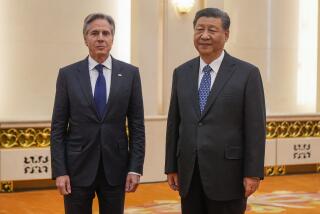Viewers in the dark on digital switch
Digital television offers crystal-clear pictures, but the federal government’s efforts to educate the public about the industry’s switch in early 2009 is drawing heavy static from some lawmakers and broadcasters.
Although the federal government has mandated that all TV stations turn off their analog signals and broadcast only in digital starting Feb. 18, 2009, congressional investigators have found that no agency is in charge of the complex transition. And Congress warned officials from the Federal Communications Commission and the Commerce Department on Wednesday that they needed to get their act together quickly or millions of Americans who rely on over-the-air TV could see their sets go dark.
“Instead of a digital revolution, we may find ourselves in a digital disaster,” said Senate Commerce Committee Chairman Daniel K. Inouye (D-Hawaii).
A federal program to provide subsidized converter boxes so people with older sets would still be able to watch broadcast TV is supposed to start Jan. 1, 2008. But lawmakers heard Wednesday that it might not be ready, even as the TV industry airs ads announcing the date and retailers such as Best Buy Co. are lining up to participate.
And a recent poll by the Assn. of Public Television Stations found that although public awareness of the digital transition was improving, 51% still had “no idea” it is taking place.
Inouye called for a high-level, inter-agency task force similar to the one the government set up in the late 1990s to address potential Y2K computer problems. FCC Commissioner Jonathan S. Adelstein agreed.
“We are sending out weak signals, so the public isn’t getting a clear picture,” Adelstein told senators. “How can there be a plan if nobody’s in charge?”
People with new digital or high-definition sets will have no problem, and neither will those who get their broadcast stations through cable or satellite. But millions of households that rely on antennas could be in trouble unless they upgrade to a digital set or a converter box.
The number of households that rely on over-the-air signals ranges from 13% to 20%. Many of those people are poor, elderly, minorities or live in rural areas, and the federal government plans to focus on educating them.
At a House subcommittee hearing Wednesday, Rep. Edward J. Markey (D-Mass.) told FCC Chairman Kevin J. Martin that he should be the quarterback for the transition.
But Martin didn’t want the ball. Although the FCC is trying to coordinate major aspects of the transition, Martin noted that Congress put the Commerce Department in charge of the $1.5-billion converter box program. And he said an interagency task force would require a White House directive, which he didn’t expect.
Still, Martin said the FCC has asked Congress for an additional $1.5 million in fiscal 2008 to help educate the public. And he has proposed requiring broadcasters to air public-service announcements about the digital television transition in prime time and throughout the day.
The National Assn. of Broadcasters this week announced its own consumer-education plan valued at $698 million, including public-service announcements and notices running across the bottom of TV screens during newscasts.
But John Lawson, president of the public television association, said the federal government must do more. Although Congress has allocated $5 million to the Commerce Department to educate the public, Lawson said at least $20 million more was needed.
John M.R. Kneuer, head of the National Telecommunications and Information Administration at the Commerce Department, told the House subcommittee that converter boxes from two manufacturers, LG Electronics and Digital Stream USA, had been certified by the government and more were expected.
Each household will be eligible for two $40 coupons to offset the purchase of no-frills converter boxes expected to cost about $60.
The Commerce Department will start accepting coupon applications Jan. 1. But Kneuer told senators that the boxes might not be in stores by then, and coupons will not go out until they are available.
More to Read
Start your day right
Sign up for Essential California for news, features and recommendations from the L.A. Times and beyond in your inbox six days a week.
You may occasionally receive promotional content from the Los Angeles Times.







